In 2017, the editors of the eLearning Journal published the largest study on the use of eLearning in German-speaking countries for the fourth time with 865 study participants. Under the motto “eLearning & Continuing Education”, eLearning professionals and those responsible for continuing education from companies and organizations in Germany, Austria and Switzerland were asked about the learning worlds in their homes. The study participants answered 51 questions about the current and future use of eLearning. The analysis of the answers provides a hitherto unique wealth of data, provides new insights and dispels a multitude of myths on the subject of “Corporate eLearning”.
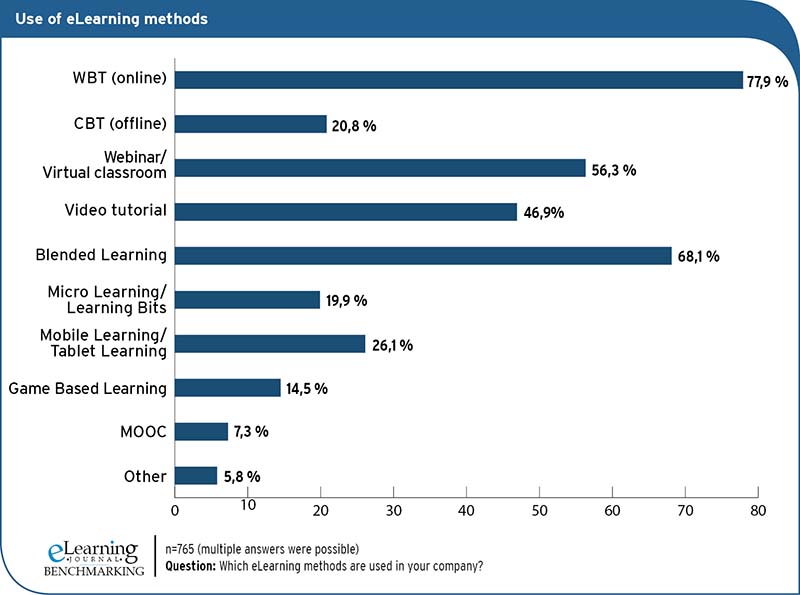
In terms of content, the eLearning BENCHMARKING Study 2017 has developed further. In addition to general questions on the use of eLearning scenarios, the current study for the first time includes a total of 5 topic clusters that examine various aspects of the topic of “eLearning” in more detail: Gamification, Talent Management, Digital Transformation, Learning Management Systems and eLearning Budgeting. In the following article and in the Trend Report in general, highlights from the various sub studies are taken up and compared with the results of other studies.
WBTs are the dominant eLearning method
When it comes to eLearning, this term covers a whole range of different methods and technologies that are used in the context of education and knowledge transfer in companies. For 4 years now, the eLearning Journal has been asking participants in the eLearning BENCHMARKING studies about the actual use of typical eLearning methods in everyday practice.
The results of the current eLearning BENCHMARKING Study 2017 largely confirm the trends from previous years. Not surprisingly, Web Based Trainings (WBTs) are and remain the most widely used eLearning method in German-speaking countries. With 77.9% responses, WBTs are clearly ahead of the other methods and underline the central role they play in in-company training in the local market. In second place, with 68.1 %, is Blended Learning, i.e. the combination of e-learning measures with face-to-face events.
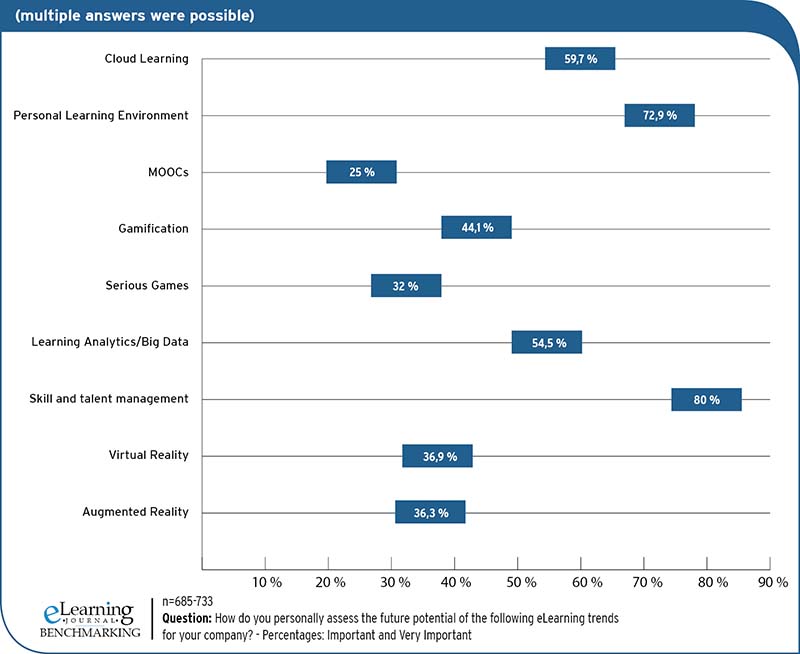
In addition to WBTs, Blended Learning has been the second pillar of corporate eLearning for years. In particular, the great flexibility and the combination of the advantages of eLearning and face-to-face training make this approach interesting for a large majority of the companies surveyed. Over the last 4 years, webinars and virtual classrooms have undergone a continuously positive development. A majority of 56.3% of the companies surveyed now use this technology, with the help of which many of the advantages of face-to-face events, such as synchronous and collaborative learning, can be used without having to do without the advantages of eLearning, such as spatial flexibility. This puts webinars and virtual classrooms in third place behind WBTs and Blended Learning. Video training has undergone a similar development, because the use of this method, based on the results of the eLearning BENCHMARKING studies, has also increased constantly over the last few years. Currently, 46.9 % of companies already use videos & co. to convey learning content – and the trend is rising.
In contrast, the two trend themes of Mobile Learning and Game Based Learning continue to play a rather subordinate role. Although Mobile Learning has probably been the biggest trend in eLearning in recent years, the actual use of this approach in everyday practice looks much more sober. Only 26.1% of the study participants stated that Mobile Learning has been used in their home so far. Thus, despite the advantages of the compatibility of learning content with mobile devices, in particular the great spatial and temporal flexibility for learners, for whom most companies remain irrelevant and confirm the low dissemination rates of previous years. The topic of Game Based Learning is also only used by a minority of the companies surveyed (14.5 %).
Future potential of eLearning trends
In practice, the “classics” around Web-based Training and Blended Learning still dominate in eLearning methods. However, in addition to Mobile Learning, Game Based Learning or Social Learning, there are currently a whole series of new technologies and trends that could potentially be of interest to the eLearning market. As part of the eLearning BENCHMARKING Study 2017, the participants asked a selection of different trends about their future potential.
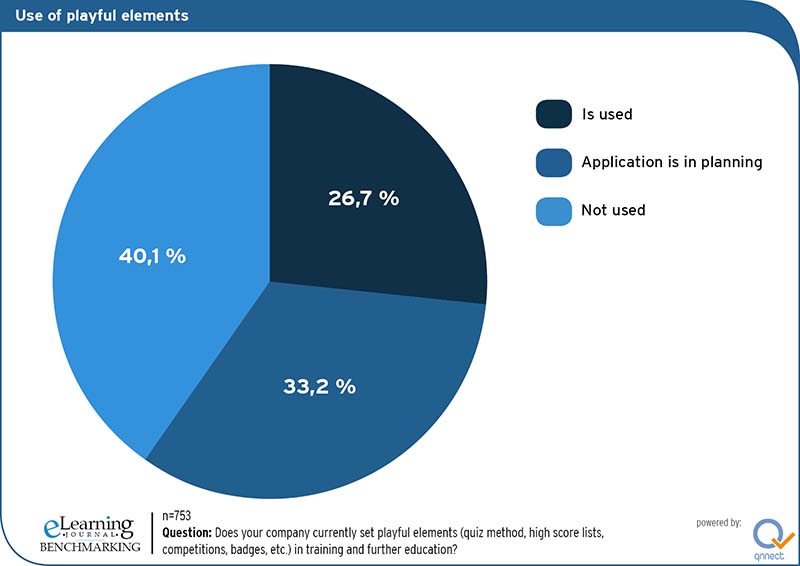
The greatest future potential is therefore attributed to the topic of Skills and Talent Management. With 80% of entries, 4 out of 5 companies consider this topic to be very important or important. The high relevance of this topic is no surprise in an age of (imminent) shortage of skilled workers. Skill and Talent Management is a key aspect of the widespread approach to Talent Management, which helps companies minimize the impact of skills shortages and demographic change.
Another topic to which study participants attach great potential for the coming years is the Personal Learning environment, with 72.9% of respondents citing it. Driven by ongoing digitization, the trend in corporate learning is towards an ever-increasing personalization of learning, which means that learners are only provided with exactly the learning content that is really relevant to their level of knowledge and tasks. With modern software, e.g. in some Learning Management sSystems, such a process can be increasingly automated.
In the last 1 to 2 years the two topics Virtual Reality (VR) and Augmented Reality (AR) have found a place in the portfolio of more and more eLearning providers. In the entertainment industry in particular, these two technologies have repeatedly made waves in recent years. On the technical side, thanks to new data glasses, many of the hurdles that have made the widespread use of VR and AR difficult, have now been overcome. The use of this technology in the educational context seems to be a logical step, e.g. in the form of realistic simulations with VR or the provision of information in the work process as performance support with AR. After all, just over a third of the study participants rate both VR (36.9 %) and AR (36.3 %) as very important or important in the future. This means, that these two topics will probably remain a niche technology for company-based education for many years to come, but their prevalence will increase significantly compared to today.
Social Learning still a niche topic
The last decade has been dominated by social media. With the help of a nationwide distribution of smartphones and tablets, Facebook, Twitter and Co. have significantly influenced and changed our society. It was recognized early on, that the social media in the form of Social Learning could also offer numerous advantages for in-company education. With Social Learning, typical characteristics of social media such as user-generated content, exchange of experience and collaboration are to be made usable for company training and further education. But what is the status quo of Social Learning in companies?
Within the framework of the eLearning BENCHMARKING Study 2017, the eLearning Journal had various statements on the subject of Social Learning evaluated by the study participants. The overall picture is that Social Learning is still largely a marginal topic and has so far only been partially used in in-company education. So far, only a minority of 23.8 % already support the topic of Social Learning in their own company. From the perspective of various stakeholders, the HR department in particular (35.9%) seems to have an interest in the use of Social Learning. The interest in the topic looks much more sober among learners (23.4%) and management (19.9%). Even if a company provides Social Learning tools, their use still seems to be very mixed. Only 12.2% of the study participants agreed with the statement that Social Learning offers and tools are used by employees.
Use of playful elements in German-speaking countries
The basic idea behind the term “Gamification” is actually relatively simple. Typical game elements such as badges, scoreboards, progress bars, points or competitions with other players should make monotone and boring tasks and processes more interesting and exciting. In the context of company-based education, these and similar game elements are intended in particular to increase motivation to learn and thus not only increase acceptance among learners, but also improve the actual learning success. So much for the theory. But how widespread is Gamification in everyday practice in German-speaking countries?
The results of the eLearning BENCHMARKING Study 2017 show that the use of playful elements in initial and continuing vocational training is currently still quite manageable at 26.7%. In the coming years, however, this value should increase significantly, as 33.2% of the companies surveyed stated, that the use of playful elements is in the planning stage and should be used in the future. Conversely, however, this also means that, at 40.1 %, a substantial proportion of companies will continue to have no significance for Gamification in the future.
A look at the use of playful elements in training and further education according to company size confirms the general trend, that company size plays an important role in the dissemination of innovations in the e-learning sector and in particular large companies have a certain pioneering position. For companies with more than 25,000 employees, the distribution of 44.1% is well above the average and more than twice as high as for companies with fewer than 500 employees, of which only around 21.1% already use Gamification elements. If one also considers those companies that plan to use playful elements, the figure for companies with more than 25,000 employees is 72.9%, or almost three-quarters of companies of this size, while the comparative figure for companies with fewer than 500 employees is 48.9%.
Importance of Talent Management is high
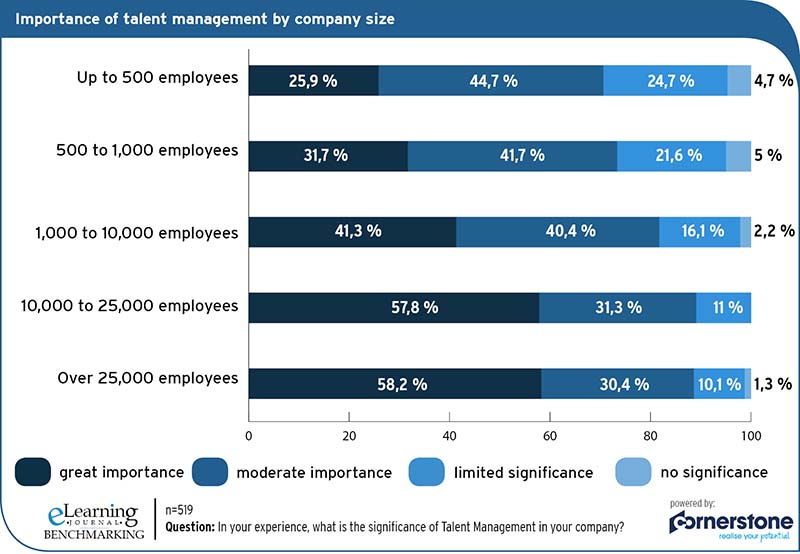
Recruiting, identifying, developing and retaining talent are cornerstones of Talent Management and should ensure that their personnel needs can be met. As there is already a shortage of skilled workers in certain industries and regions, it seems likely that Talent Management is already relevant for companies today and should become increasingly important in the future. At least in relation to the present, this assumption is supported by the results of the eLearning BENCHMARKING Study 2017. Of the companies surveyed, Talent Management is of high (42.2 %) or moderate (38.7 %) importance with 81.1 %. With 2.5 % of entries, companies in which Talent Management does not play a role, according to their own statements, are virtually unrepresented.
Within the DACH region surveyed, Talent Management seems to be of particular relevance in Switzerland. With 91.5 % of the entries, more than 9 out of 10 Swiss companies give Talent Management a high or moderate interpretation. In Germany and Austria, the comparative figures of 80.5 % and 71.9 % respectively are around 10 and 20 % lower.
A look at the industries shows that there are in particular 3 outliers that differ from the masses in the importance of Talent Management. The greatest importance is attached to Talent Management in the resource industry. For 94.1 % of the companies in this sector, Talent Management is either of high or moderate importance. The topic also seems to have a very high relevance for companies in the manufacturing sector, for which the comparative figure is 88.9 %. On the other hand, public administrations are by far the least significant (20 % high and 42.5 % moderate) (together 62.5 %), which is surprising, as public administration is often particularly hard hit by the shortage of skilled workers due to competitive disadvantages in remuneration compared to the free economy, which should actually make Talent Management even more relevant.
Digitization is very important in training strategies
In digital transformation, the skills of employees play a decisive role; after all, the best new technology is of little use if the workforce can only partially or not at all take advantage of its benefits. In order to make employees fit for the digitalized world of work, in-company training and further education plays a central role. But has this insight already reached the companies?
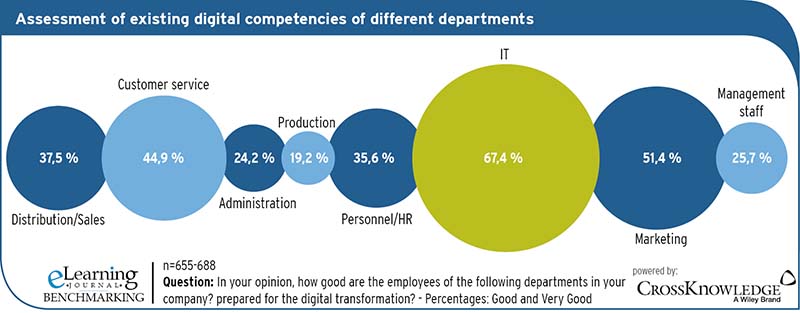
Against this background, it is therefore no surprise that digitization has become a high priority in training strategies in Germany, Austria and Switzerland. Within the framework of the current eLearning BENCH-MARKING Study 2017, a clear majority of 61.8 % of the companies surveyed stated that the topic of digitization and digital transformation is given a high (33 %) or at least a moderate (28.8 %) importance in the company’s training strategy. The topic is of little or no importance in only about 20 % of the companies surveyed.
It is also astonishing that a substantial 18.5% of the study participants have not defined a training strategy in their company. If you exclude these companies from the results, then the importance of digitization is even clearer, because among the companies that had defined a training strategy in their company, even more than three quarters (75.89%) of those surveyed, attach high (40.54%) or moderate importance to the topic (35.36%).
The eLearning BENCHMARKING Study 2017 provides a clear picture in terms of company size: the larger the company, the greater the importance for the training strategy. While companies with up to 500 employees (54.78%) attach high or moderate importance to digitization in their training strategies, this figure is already almost three quarters for large companies with more than 25,000 employees (74.07%). The difference is even more pronounced among the companies for which the topic is of great importance. While this figure is 26.96% for companies with up to 500 employees, it almost doubles to 49.07% for companies with more than 25,000 employees.
LMS penetration remains at a consistently high level
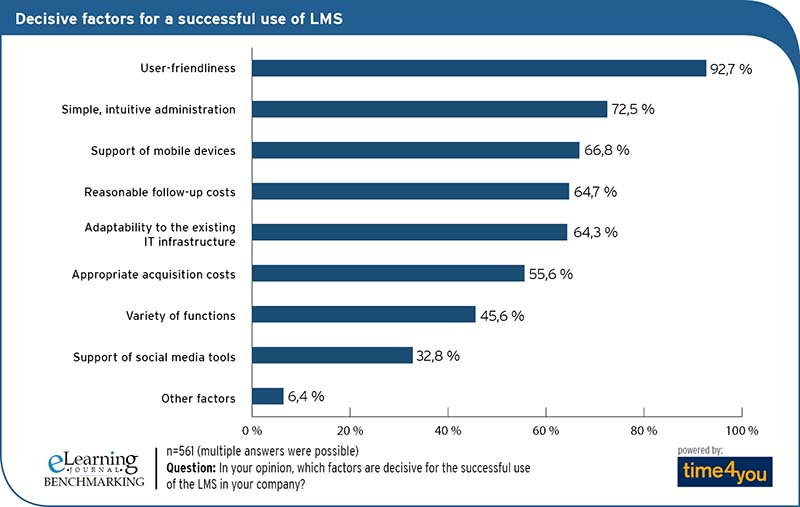
Within the framework of the eLearning BENCHMARKING Study 2017, the eLearning Journal once again wanted to determine the distribution of LMS in the German-speaking region and thus make the figures from the pilot study of 2014 more relevant. In the current study, 72.1% of the companies surveyed stated that an LMS is currently being used in their company. This means, that the distribution of LMS in German-speaking countries has remained virtually constant over the last four years. Among the companies that do not currently use LMS, such a system is planned in almost half of the cases (14%), i.e. only 14% of the study participants stated that neither an LMS is used nor planned.
There seem to be slight differences in the dissemination of LMS between the different countries. This is because in companies from Germany 71.3 % and in Austria 69.3 % of all cases use an LMS. In Switzerland, on the other hand, the comparable figure of 80.8 % is around 10 % higher.
A glance at the size of the company reveals once again that the spread of large and often expensive infrastructure software correlates with the size of the company. In medium-sized companies with fewer than 1,000 employees, LMS is used in only 53% of the companies surveyed, just over half of them. In the target group of 1,000 to 10,000 employees, the comparative figure of 72.8 % is virtually at the average level of all study participants. On the other hand, more than 10,000 employees in companies use LMS almost nationwide with a spread of just over 90%.





